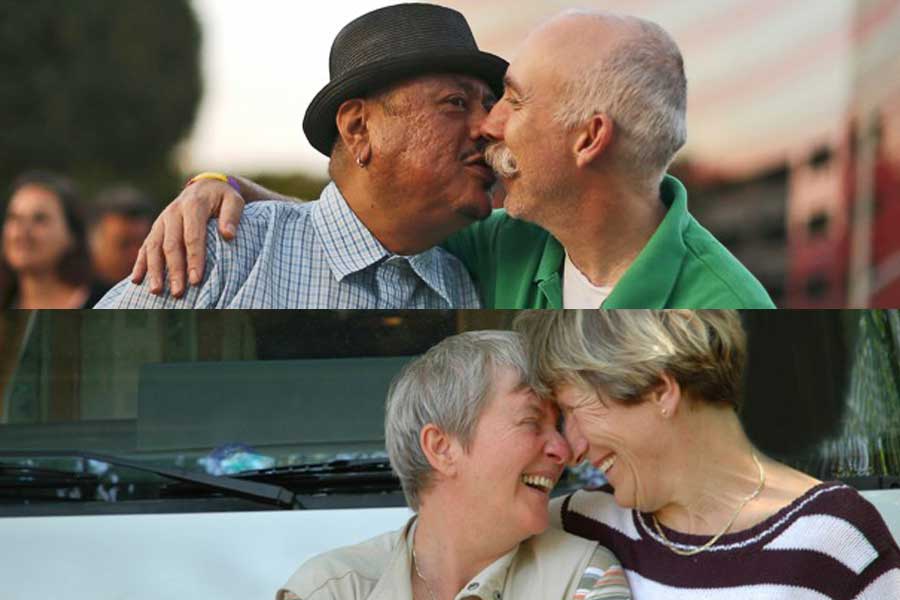Many organizations that serve older adults have started to make a greater effort to reach LGBTQ elders and to create spaces that are welcoming to people of all sexual orientations and gender identities. But how would anyone know you’re a safe space if you don’t show and tell them?
Don’t downplay the importance of proudly displaying your LGBTQ-inclusivity to incoming seniors of all backgrounds. Some agencies may experience some apprehension that displaying their LGBTQ cultural competence may “scare off all the straight people.”
But in that case, ask yourself and your organization if you’re more concerned with making straight and cisgender folks [remain] comfortable than with ensuring there is a safe and nondiscriminatory environment for your LGBTQ participants.
Becoming a safe space is an entire culture shift for not just your frontline staff or administration, but the entire organization. Sure, this process takes courage and perseverance, but that is the point. There is no room for partial investments here. You have to be fully invested and genuine from the beginning.
The following list outlines some steps that organizations can take toward becoming more culturally competent. These are also some questions that LGBTQ elders may want to consider when selecting an agency from which to receive services.
- Has your staff been trained? The National Resource Center on LGBT Aging offers wonderful comprehensive trainings for aging-services providers to gain cultural competencies on working with seniors of all sexual orientations and gender identities. It provides a national network of trainers who can work with your organization to prepare your staff to better serve LGBTQ older adults. More information on these trainings is available at www.lgbtagingcenter.org/training.
- Are you using inclusive language in your organization’s documents? On any intake forms or documents where seniors share their contact information or names of next of kin, make sure your gender category includes more than just woman/man or female/male. Including terminology like transgender/gender-nonconforming or leaving a blank space for someone to write in their gender will leave room for people to identify as they see fit. Also, replacing gendered language to terms like “partner,” “significant other” or “spouse” instead of “husband” or “wife” will show that you don’t assume everyone is in a traditionally heteronormative relationship and that you recognize all commitments. A great resource on this is SAGE’s “Inclusive Questions for Older Adults: A Practical Guide to Collecting Data on Sexual Orientation and Gender Identity,” which can be found online.
- Are you verbalizing your inclusive language? Don’t limit your inclusive language to just your walls or forms. Normalizing this language will help others at your agency speak about these subjects as well. Speaking openly about LGBTQ issues and using inclusive language in daily interactions will help to signal that your organization is a supportive place for LGBTQ folks. When engaging in conversation, ask for people’s gender pronouns and partnerships in a neutral way. For example, instead of asking about a person’s husband or wife, you can ask them who the important people in their life are. This leaves room for them to share what they feel comfortable sharing.
- Do your promotional materials include LGBTQ people? Does your agency have decorative photos or brochures in your common areas? If there are couples featured in those materials, make sure some of them are same-sex couples. This is an easy way to model that you recognize more than just traditional heteronormative relationships. Your materials should also offer visibility for transgender and gender-nonconforming seniors as well to indicate your support for people of all gender identities.
- Are you remembering the “T” in LGBTQ? While it’s great that many organizations are becoming more welcoming of gay, lesbian and bisexual individuals, many organizations that call themselves “LGBT-friendly” are still not very open to transgender issues. LGBT Elder Initiative board member Dawn Munro, a trans activist and resident of the John C. Anderson Apartments, advises for agencies to “be intentional about including transgender folks if you’re stating that you’re LGBTQ-friendly. Oftentimes the focus is exclusively on sexual orientation and there is no mention of gender identity or presentation at all.”
- Are you offering programs and services that are specific to LGBTQ people? LGBTQ folks often benefit from programs, services and resources specifically tailored to LGBTQ elders. LGBTQ older adults experience disproportionately high rates of isolation compared to the general aging population. Helping to create structured supportive communities for LGBTQ people as they age can help to improve the overall well-being of the LGBTQ older adults using your agency’s services.
- What is in your nondiscrimination policy? Where is that policy displayed? Your organization surely has a nondiscrimination policy. Make sure that sexual orientation and gender identity are explicitly included. This policy shouldn’t just been written in the fine print of an employee handbook. Your nondiscrimination policy should be clearly visible to everyone who enters the doors of your organization. Have this statement displayed throughout the facility, clearly posted on walls, in seating areas, in meeting rooms and anywhere else you can post it! This reminds everyone that there is an expectation of safety and inclusivity for all persons and welcomes everyone to hold each other accountable if those policies are not followed.
This list is not exhaustive, but hopefully provides some tips for making your environment as welcoming as possible. Your services will be most impactful when you have an inclusive and welcoming agency that is open and affirming to people of all sexual orientations and gender identities.
LaTierra Piphus is a master of social work student at the Hunter College Silberman School of Social Work and an intern with the LGBT Elder Initiative.
